Medication Practices in Healthcare Settings: A Comprehensive Report
VerifiedAdded on 2020/07/22
|11
|2429
|32
Report
AI Summary
The report analyzes effective medication practices within healthcare settings, emphasizing patient safety through appropriate prescription, administration, and monitoring. It highlights issues such as medication errors, polypharmacy, and the necessity of following regulations like the Misuse of Drugs Act 1971. The role of pharmacists in medication reconciliation is underscored, along with adherence to standards like NICE for managing conditions like diabetes. Additionally, it stresses the importance of healthcare professionals' training and continuous education to maintain competency and uphold patient safety through proper medication management.
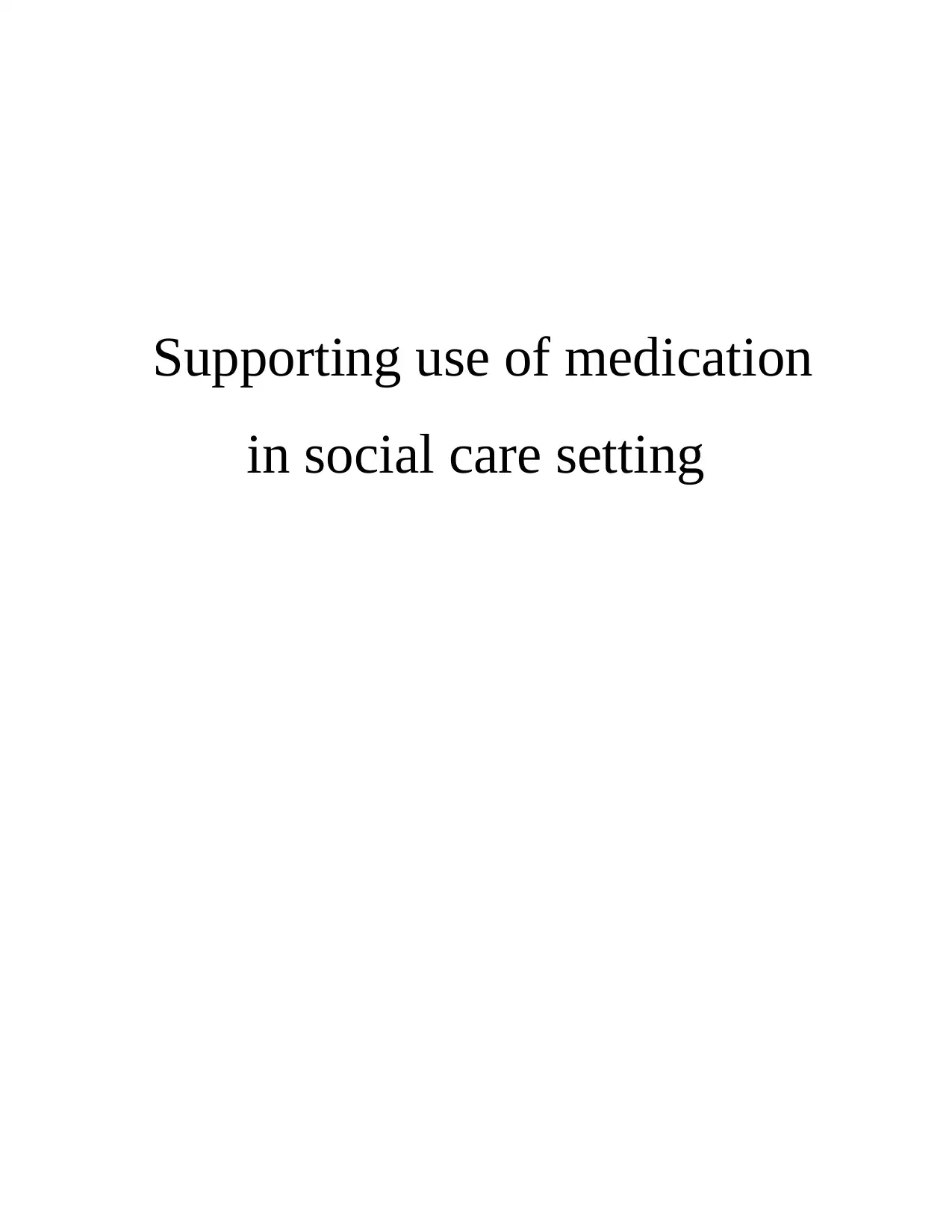
Supporting use of medication
in social care setting
in social care setting
Paraphrase This Document
Need a fresh take? Get an instant paraphrase of this document with our AI Paraphraser
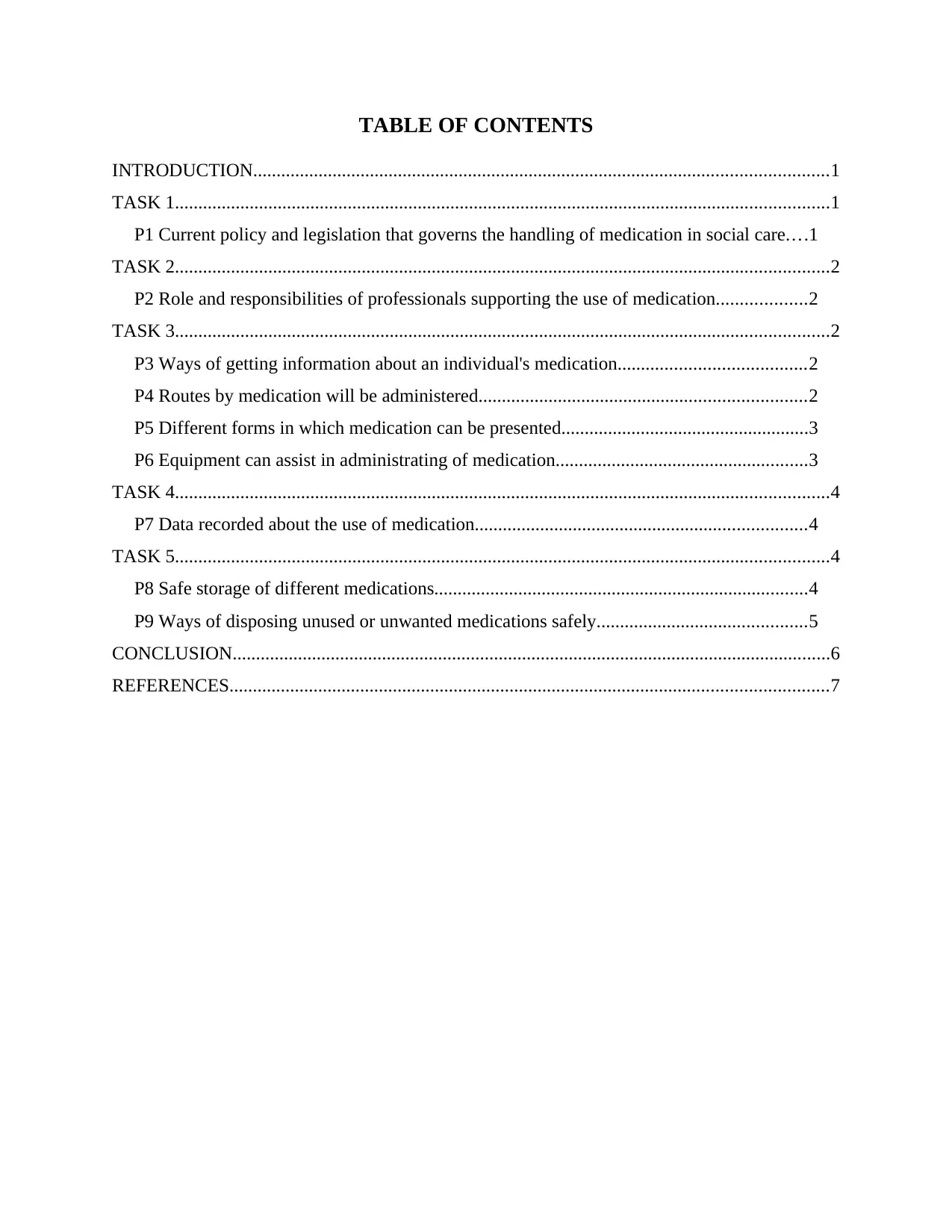
TABLE OF CONTENTS
INTRODUCTION...........................................................................................................................1
TASK 1............................................................................................................................................1
P1 Current policy and legislation that governs the handling of medication in social care....1
TASK 2............................................................................................................................................2
P2 Role and responsibilities of professionals supporting the use of medication...................2
TASK 3............................................................................................................................................2
P3 Ways of getting information about an individual's medication........................................2
P4 Routes by medication will be administered......................................................................2
P5 Different forms in which medication can be presented.....................................................3
P6 Equipment can assist in administrating of medication......................................................3
TASK 4............................................................................................................................................4
P7 Data recorded about the use of medication.......................................................................4
TASK 5............................................................................................................................................4
P8 Safe storage of different medications................................................................................4
P9 Ways of disposing unused or unwanted medications safely.............................................5
CONCLUSION................................................................................................................................6
REFERENCES................................................................................................................................7
INTRODUCTION...........................................................................................................................1
TASK 1............................................................................................................................................1
P1 Current policy and legislation that governs the handling of medication in social care....1
TASK 2............................................................................................................................................2
P2 Role and responsibilities of professionals supporting the use of medication...................2
TASK 3............................................................................................................................................2
P3 Ways of getting information about an individual's medication........................................2
P4 Routes by medication will be administered......................................................................2
P5 Different forms in which medication can be presented.....................................................3
P6 Equipment can assist in administrating of medication......................................................3
TASK 4............................................................................................................................................4
P7 Data recorded about the use of medication.......................................................................4
TASK 5............................................................................................................................................4
P8 Safe storage of different medications................................................................................4
P9 Ways of disposing unused or unwanted medications safely.............................................5
CONCLUSION................................................................................................................................6
REFERENCES................................................................................................................................7
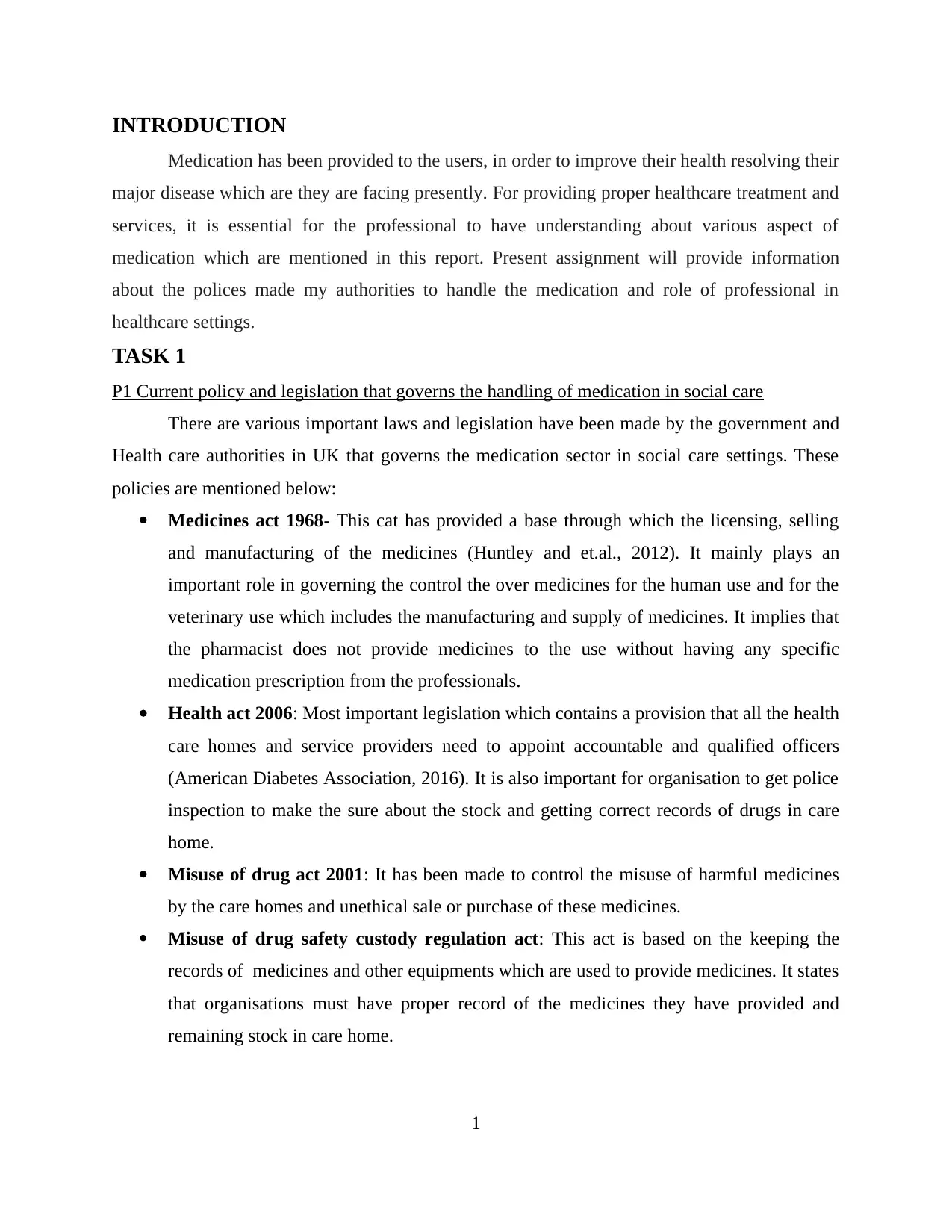
INTRODUCTION
Medication has been provided to the users, in order to improve their health resolving their
major disease which are they are facing presently. For providing proper healthcare treatment and
services, it is essential for the professional to have understanding about various aspect of
medication which are mentioned in this report. Present assignment will provide information
about the polices made my authorities to handle the medication and role of professional in
healthcare settings.
TASK 1
P1 Current policy and legislation that governs the handling of medication in social care
There are various important laws and legislation have been made by the government and
Health care authorities in UK that governs the medication sector in social care settings. These
policies are mentioned below:
Medicines act 1968- This cat has provided a base through which the licensing, selling
and manufacturing of the medicines (Huntley and et.al., 2012). It mainly plays an
important role in governing the control the over medicines for the human use and for the
veterinary use which includes the manufacturing and supply of medicines. It implies that
the pharmacist does not provide medicines to the use without having any specific
medication prescription from the professionals.
Health act 2006: Most important legislation which contains a provision that all the health
care homes and service providers need to appoint accountable and qualified officers
(American Diabetes Association, 2016). It is also important for organisation to get police
inspection to make the sure about the stock and getting correct records of drugs in care
home.
Misuse of drug act 2001: It has been made to control the misuse of harmful medicines
by the care homes and unethical sale or purchase of these medicines.
Misuse of drug safety custody regulation act: This act is based on the keeping the
records of medicines and other equipments which are used to provide medicines. It states
that organisations must have proper record of the medicines they have provided and
remaining stock in care home.
1
Medication has been provided to the users, in order to improve their health resolving their
major disease which are they are facing presently. For providing proper healthcare treatment and
services, it is essential for the professional to have understanding about various aspect of
medication which are mentioned in this report. Present assignment will provide information
about the polices made my authorities to handle the medication and role of professional in
healthcare settings.
TASK 1
P1 Current policy and legislation that governs the handling of medication in social care
There are various important laws and legislation have been made by the government and
Health care authorities in UK that governs the medication sector in social care settings. These
policies are mentioned below:
Medicines act 1968- This cat has provided a base through which the licensing, selling
and manufacturing of the medicines (Huntley and et.al., 2012). It mainly plays an
important role in governing the control the over medicines for the human use and for the
veterinary use which includes the manufacturing and supply of medicines. It implies that
the pharmacist does not provide medicines to the use without having any specific
medication prescription from the professionals.
Health act 2006: Most important legislation which contains a provision that all the health
care homes and service providers need to appoint accountable and qualified officers
(American Diabetes Association, 2016). It is also important for organisation to get police
inspection to make the sure about the stock and getting correct records of drugs in care
home.
Misuse of drug act 2001: It has been made to control the misuse of harmful medicines
by the care homes and unethical sale or purchase of these medicines.
Misuse of drug safety custody regulation act: This act is based on the keeping the
records of medicines and other equipments which are used to provide medicines. It states
that organisations must have proper record of the medicines they have provided and
remaining stock in care home.
1
⊘ This is a preview!⊘
Do you want full access?
Subscribe today to unlock all pages.

Trusted by 1+ million students worldwide
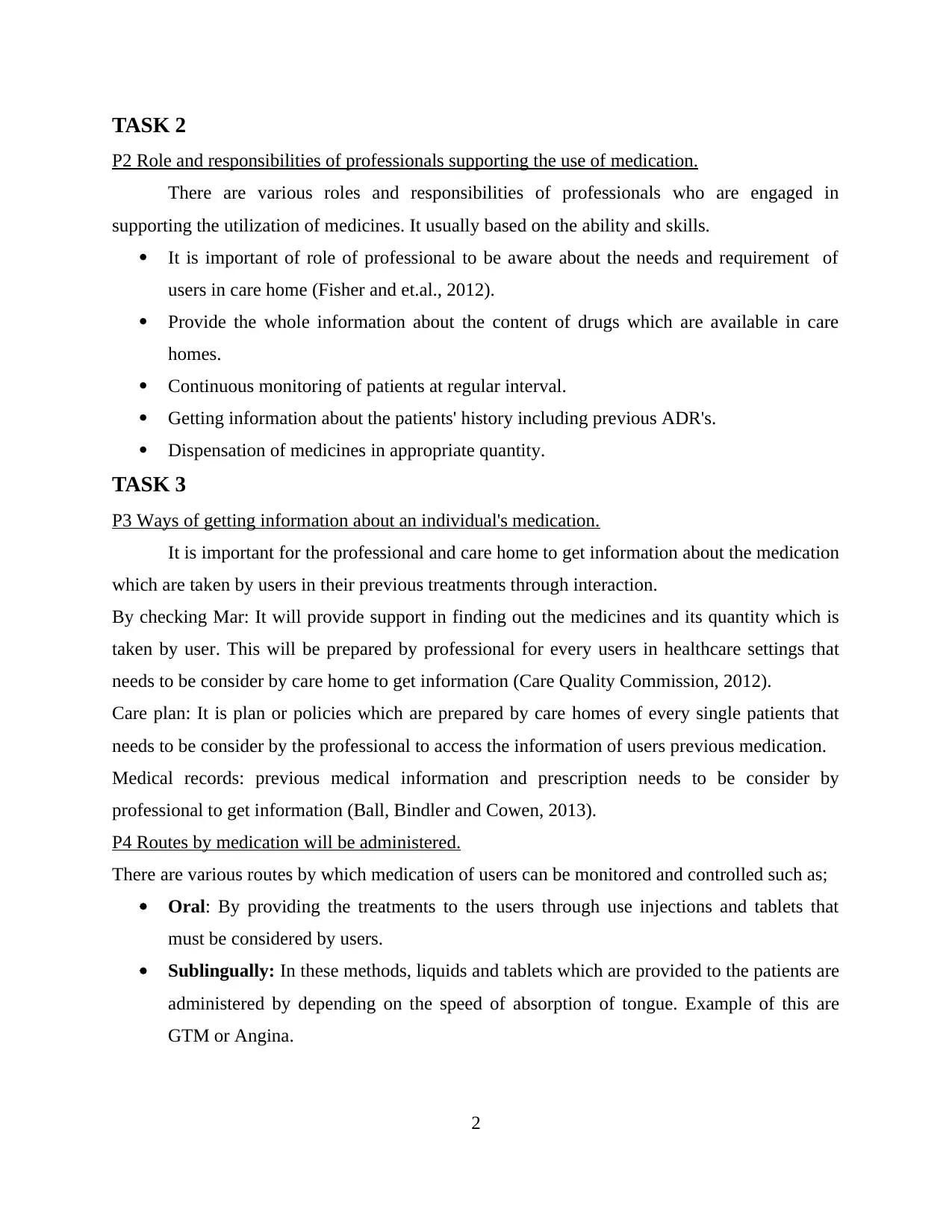
TASK 2
P2 Role and responsibilities of professionals supporting the use of medication.
There are various roles and responsibilities of professionals who are engaged in
supporting the utilization of medicines. It usually based on the ability and skills.
It is important of role of professional to be aware about the needs and requirement of
users in care home (Fisher and et.al., 2012).
Provide the whole information about the content of drugs which are available in care
homes.
Continuous monitoring of patients at regular interval.
Getting information about the patients' history including previous ADR's.
Dispensation of medicines in appropriate quantity.
TASK 3
P3 Ways of getting information about an individual's medication.
It is important for the professional and care home to get information about the medication
which are taken by users in their previous treatments through interaction.
By checking Mar: It will provide support in finding out the medicines and its quantity which is
taken by user. This will be prepared by professional for every users in healthcare settings that
needs to be consider by care home to get information (Care Quality Commission, 2012).
Care plan: It is plan or policies which are prepared by care homes of every single patients that
needs to be consider by the professional to access the information of users previous medication.
Medical records: previous medical information and prescription needs to be consider by
professional to get information (Ball, Bindler and Cowen, 2013).
P4 Routes by medication will be administered.
There are various routes by which medication of users can be monitored and controlled such as;
Oral: By providing the treatments to the users through use injections and tablets that
must be considered by users.
Sublingually: In these methods, liquids and tablets which are provided to the patients are
administered by depending on the speed of absorption of tongue. Example of this are
GTM or Angina.
2
P2 Role and responsibilities of professionals supporting the use of medication.
There are various roles and responsibilities of professionals who are engaged in
supporting the utilization of medicines. It usually based on the ability and skills.
It is important of role of professional to be aware about the needs and requirement of
users in care home (Fisher and et.al., 2012).
Provide the whole information about the content of drugs which are available in care
homes.
Continuous monitoring of patients at regular interval.
Getting information about the patients' history including previous ADR's.
Dispensation of medicines in appropriate quantity.
TASK 3
P3 Ways of getting information about an individual's medication.
It is important for the professional and care home to get information about the medication
which are taken by users in their previous treatments through interaction.
By checking Mar: It will provide support in finding out the medicines and its quantity which is
taken by user. This will be prepared by professional for every users in healthcare settings that
needs to be consider by care home to get information (Care Quality Commission, 2012).
Care plan: It is plan or policies which are prepared by care homes of every single patients that
needs to be consider by the professional to access the information of users previous medication.
Medical records: previous medical information and prescription needs to be consider by
professional to get information (Ball, Bindler and Cowen, 2013).
P4 Routes by medication will be administered.
There are various routes by which medication of users can be monitored and controlled such as;
Oral: By providing the treatments to the users through use injections and tablets that
must be considered by users.
Sublingually: In these methods, liquids and tablets which are provided to the patients are
administered by depending on the speed of absorption of tongue. Example of this are
GTM or Angina.
2
Paraphrase This Document
Need a fresh take? Get an instant paraphrase of this document with our AI Paraphraser
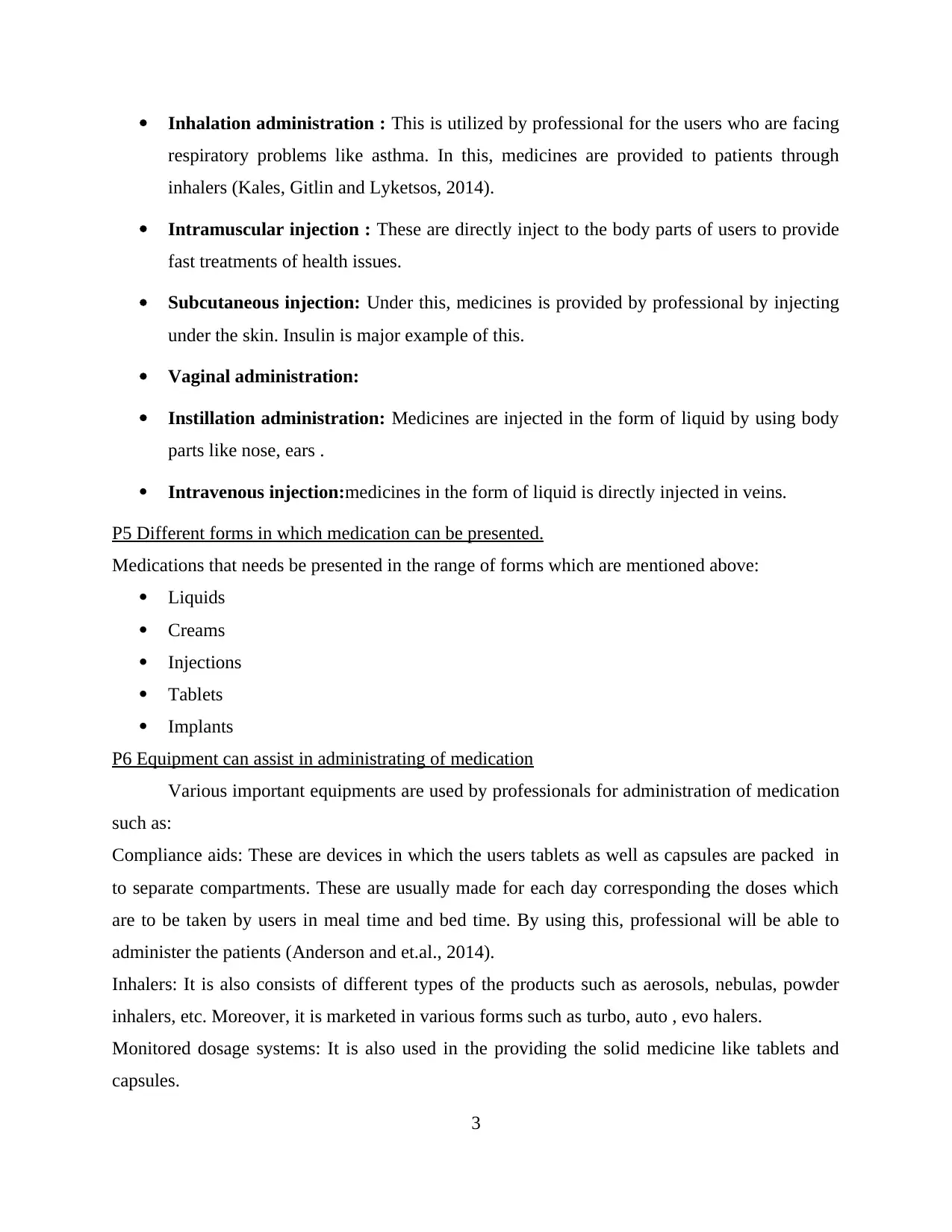
Inhalation administration : This is utilized by professional for the users who are facing
respiratory problems like asthma. In this, medicines are provided to patients through
inhalers (Kales, Gitlin and Lyketsos, 2014).
Intramuscular injection : These are directly inject to the body parts of users to provide
fast treatments of health issues.
Subcutaneous injection: Under this, medicines is provided by professional by injecting
under the skin. Insulin is major example of this.
Vaginal administration:
Instillation administration: Medicines are injected in the form of liquid by using body
parts like nose, ears .
Intravenous injection:medicines in the form of liquid is directly injected in veins.
P5 Different forms in which medication can be presented.
Medications that needs be presented in the range of forms which are mentioned above:
Liquids
Creams
Injections
Tablets
Implants
P6 Equipment can assist in administrating of medication
Various important equipments are used by professionals for administration of medication
such as:
Compliance aids: These are devices in which the users tablets as well as capsules are packed in
to separate compartments. These are usually made for each day corresponding the doses which
are to be taken by users in meal time and bed time. By using this, professional will be able to
administer the patients (Anderson and et.al., 2014).
Inhalers: It is also consists of different types of the products such as aerosols, nebulas, powder
inhalers, etc. Moreover, it is marketed in various forms such as turbo, auto , evo halers.
Monitored dosage systems: It is also used in the providing the solid medicine like tablets and
capsules.
3
respiratory problems like asthma. In this, medicines are provided to patients through
inhalers (Kales, Gitlin and Lyketsos, 2014).
Intramuscular injection : These are directly inject to the body parts of users to provide
fast treatments of health issues.
Subcutaneous injection: Under this, medicines is provided by professional by injecting
under the skin. Insulin is major example of this.
Vaginal administration:
Instillation administration: Medicines are injected in the form of liquid by using body
parts like nose, ears .
Intravenous injection:medicines in the form of liquid is directly injected in veins.
P5 Different forms in which medication can be presented.
Medications that needs be presented in the range of forms which are mentioned above:
Liquids
Creams
Injections
Tablets
Implants
P6 Equipment can assist in administrating of medication
Various important equipments are used by professionals for administration of medication
such as:
Compliance aids: These are devices in which the users tablets as well as capsules are packed in
to separate compartments. These are usually made for each day corresponding the doses which
are to be taken by users in meal time and bed time. By using this, professional will be able to
administer the patients (Anderson and et.al., 2014).
Inhalers: It is also consists of different types of the products such as aerosols, nebulas, powder
inhalers, etc. Moreover, it is marketed in various forms such as turbo, auto , evo halers.
Monitored dosage systems: It is also used in the providing the solid medicine like tablets and
capsules.
3
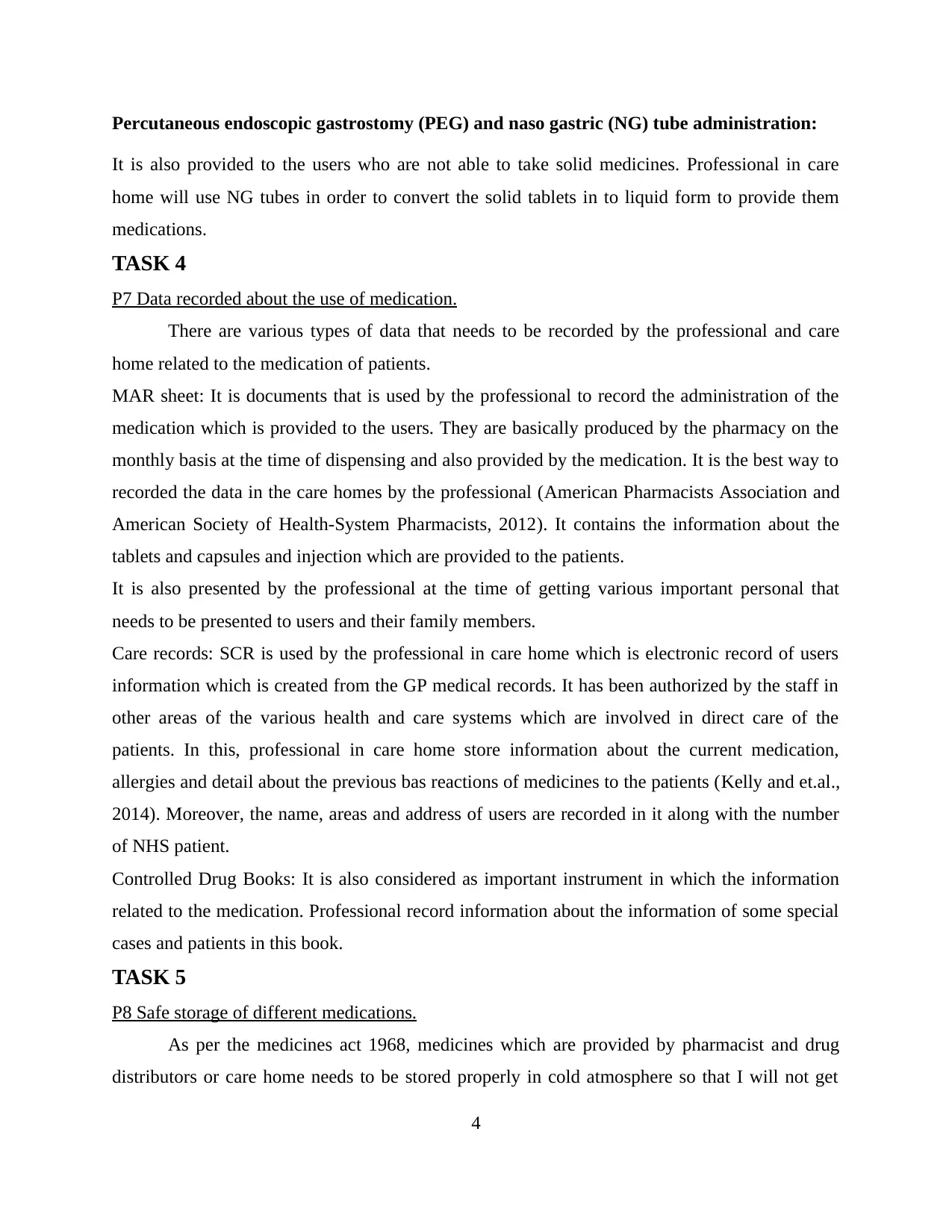
Percutaneous endoscopic gastrostomy (PEG) and naso gastric (NG) tube administration:
It is also provided to the users who are not able to take solid medicines. Professional in care
home will use NG tubes in order to convert the solid tablets in to liquid form to provide them
medications.
TASK 4
P7 Data recorded about the use of medication.
There are various types of data that needs to be recorded by the professional and care
home related to the medication of patients.
MAR sheet: It is documents that is used by the professional to record the administration of the
medication which is provided to the users. They are basically produced by the pharmacy on the
monthly basis at the time of dispensing and also provided by the medication. It is the best way to
recorded the data in the care homes by the professional (American Pharmacists Association and
American Society of Health-System Pharmacists, 2012). It contains the information about the
tablets and capsules and injection which are provided to the patients.
It is also presented by the professional at the time of getting various important personal that
needs to be presented to users and their family members.
Care records: SCR is used by the professional in care home which is electronic record of users
information which is created from the GP medical records. It has been authorized by the staff in
other areas of the various health and care systems which are involved in direct care of the
patients. In this, professional in care home store information about the current medication,
allergies and detail about the previous bas reactions of medicines to the patients (Kelly and et.al.,
2014). Moreover, the name, areas and address of users are recorded in it along with the number
of NHS patient.
Controlled Drug Books: It is also considered as important instrument in which the information
related to the medication. Professional record information about the information of some special
cases and patients in this book.
TASK 5
P8 Safe storage of different medications.
As per the medicines act 1968, medicines which are provided by pharmacist and drug
distributors or care home needs to be stored properly in cold atmosphere so that I will not get
4
It is also provided to the users who are not able to take solid medicines. Professional in care
home will use NG tubes in order to convert the solid tablets in to liquid form to provide them
medications.
TASK 4
P7 Data recorded about the use of medication.
There are various types of data that needs to be recorded by the professional and care
home related to the medication of patients.
MAR sheet: It is documents that is used by the professional to record the administration of the
medication which is provided to the users. They are basically produced by the pharmacy on the
monthly basis at the time of dispensing and also provided by the medication. It is the best way to
recorded the data in the care homes by the professional (American Pharmacists Association and
American Society of Health-System Pharmacists, 2012). It contains the information about the
tablets and capsules and injection which are provided to the patients.
It is also presented by the professional at the time of getting various important personal that
needs to be presented to users and their family members.
Care records: SCR is used by the professional in care home which is electronic record of users
information which is created from the GP medical records. It has been authorized by the staff in
other areas of the various health and care systems which are involved in direct care of the
patients. In this, professional in care home store information about the current medication,
allergies and detail about the previous bas reactions of medicines to the patients (Kelly and et.al.,
2014). Moreover, the name, areas and address of users are recorded in it along with the number
of NHS patient.
Controlled Drug Books: It is also considered as important instrument in which the information
related to the medication. Professional record information about the information of some special
cases and patients in this book.
TASK 5
P8 Safe storage of different medications.
As per the medicines act 1968, medicines which are provided by pharmacist and drug
distributors or care home needs to be stored properly in cold atmosphere so that I will not get
4
⊘ This is a preview!⊘
Do you want full access?
Subscribe today to unlock all pages.

Trusted by 1+ million students worldwide
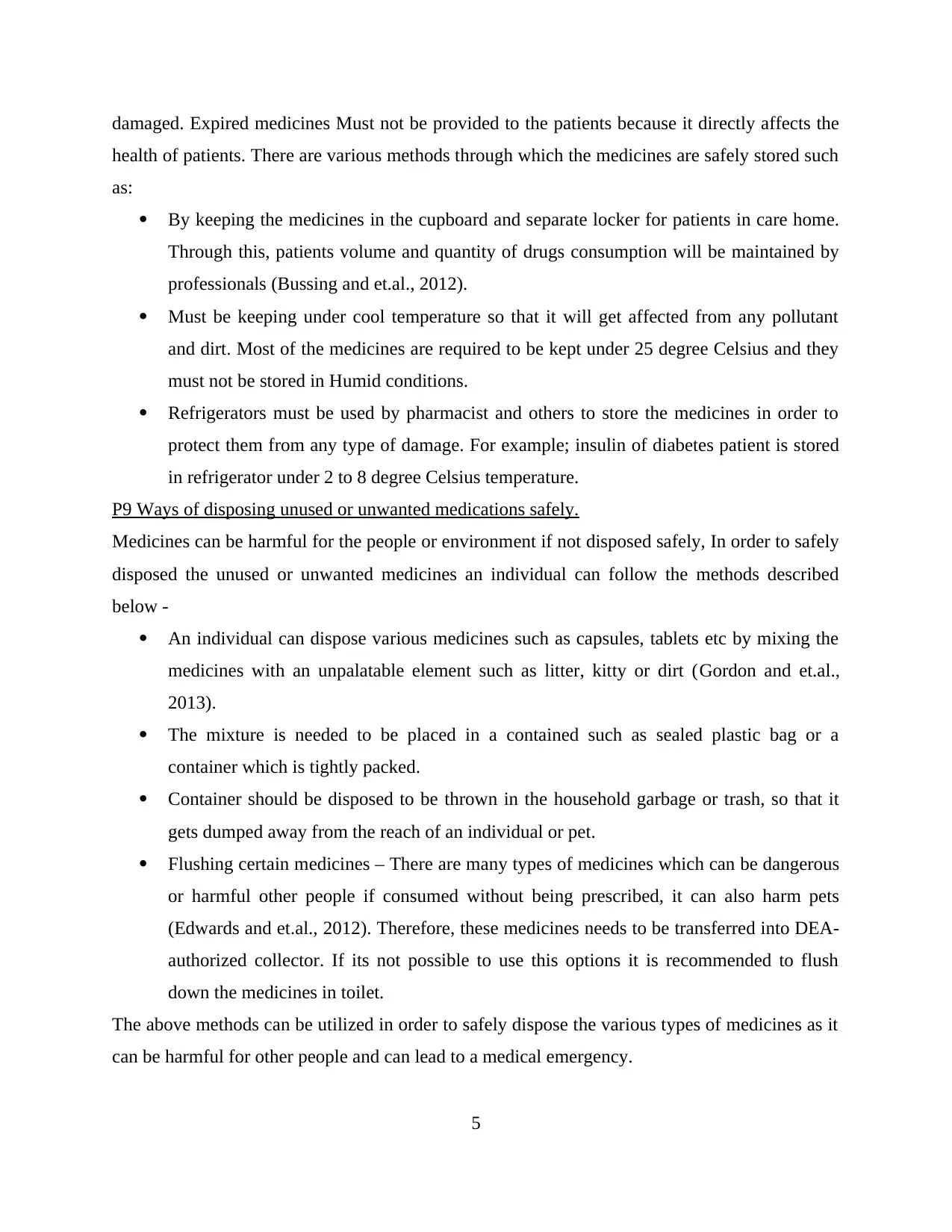
damaged. Expired medicines Must not be provided to the patients because it directly affects the
health of patients. There are various methods through which the medicines are safely stored such
as:
By keeping the medicines in the cupboard and separate locker for patients in care home.
Through this, patients volume and quantity of drugs consumption will be maintained by
professionals (Bussing and et.al., 2012).
Must be keeping under cool temperature so that it will get affected from any pollutant
and dirt. Most of the medicines are required to be kept under 25 degree Celsius and they
must not be stored in Humid conditions.
Refrigerators must be used by pharmacist and others to store the medicines in order to
protect them from any type of damage. For example; insulin of diabetes patient is stored
in refrigerator under 2 to 8 degree Celsius temperature.
P9 Ways of disposing unused or unwanted medications safely.
Medicines can be harmful for the people or environment if not disposed safely, In order to safely
disposed the unused or unwanted medicines an individual can follow the methods described
below -
An individual can dispose various medicines such as capsules, tablets etc by mixing the
medicines with an unpalatable element such as litter, kitty or dirt (Gordon and et.al.,
2013).
The mixture is needed to be placed in a contained such as sealed plastic bag or a
container which is tightly packed.
Container should be disposed to be thrown in the household garbage or trash, so that it
gets dumped away from the reach of an individual or pet.
Flushing certain medicines – There are many types of medicines which can be dangerous
or harmful other people if consumed without being prescribed, it can also harm pets
(Edwards and et.al., 2012). Therefore, these medicines needs to be transferred into DEA-
authorized collector. If its not possible to use this options it is recommended to flush
down the medicines in toilet.
The above methods can be utilized in order to safely dispose the various types of medicines as it
can be harmful for other people and can lead to a medical emergency.
5
health of patients. There are various methods through which the medicines are safely stored such
as:
By keeping the medicines in the cupboard and separate locker for patients in care home.
Through this, patients volume and quantity of drugs consumption will be maintained by
professionals (Bussing and et.al., 2012).
Must be keeping under cool temperature so that it will get affected from any pollutant
and dirt. Most of the medicines are required to be kept under 25 degree Celsius and they
must not be stored in Humid conditions.
Refrigerators must be used by pharmacist and others to store the medicines in order to
protect them from any type of damage. For example; insulin of diabetes patient is stored
in refrigerator under 2 to 8 degree Celsius temperature.
P9 Ways of disposing unused or unwanted medications safely.
Medicines can be harmful for the people or environment if not disposed safely, In order to safely
disposed the unused or unwanted medicines an individual can follow the methods described
below -
An individual can dispose various medicines such as capsules, tablets etc by mixing the
medicines with an unpalatable element such as litter, kitty or dirt (Gordon and et.al.,
2013).
The mixture is needed to be placed in a contained such as sealed plastic bag or a
container which is tightly packed.
Container should be disposed to be thrown in the household garbage or trash, so that it
gets dumped away from the reach of an individual or pet.
Flushing certain medicines – There are many types of medicines which can be dangerous
or harmful other people if consumed without being prescribed, it can also harm pets
(Edwards and et.al., 2012). Therefore, these medicines needs to be transferred into DEA-
authorized collector. If its not possible to use this options it is recommended to flush
down the medicines in toilet.
The above methods can be utilized in order to safely dispose the various types of medicines as it
can be harmful for other people and can lead to a medical emergency.
5
Paraphrase This Document
Need a fresh take? Get an instant paraphrase of this document with our AI Paraphraser
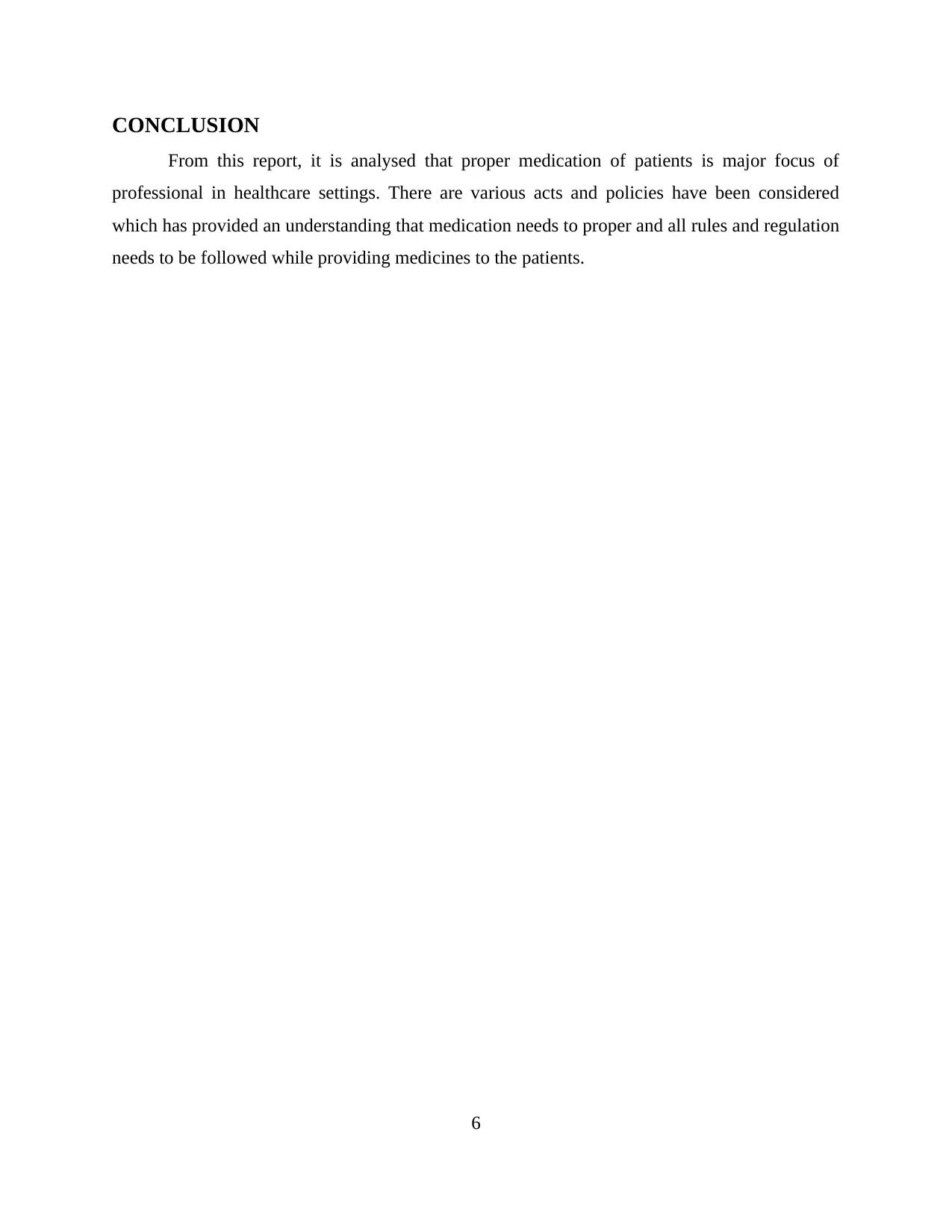
CONCLUSION
From this report, it is analysed that proper medication of patients is major focus of
professional in healthcare settings. There are various acts and policies have been considered
which has provided an understanding that medication needs to proper and all rules and regulation
needs to be followed while providing medicines to the patients.
6
From this report, it is analysed that proper medication of patients is major focus of
professional in healthcare settings. There are various acts and policies have been considered
which has provided an understanding that medication needs to proper and all rules and regulation
needs to be followed while providing medicines to the patients.
6
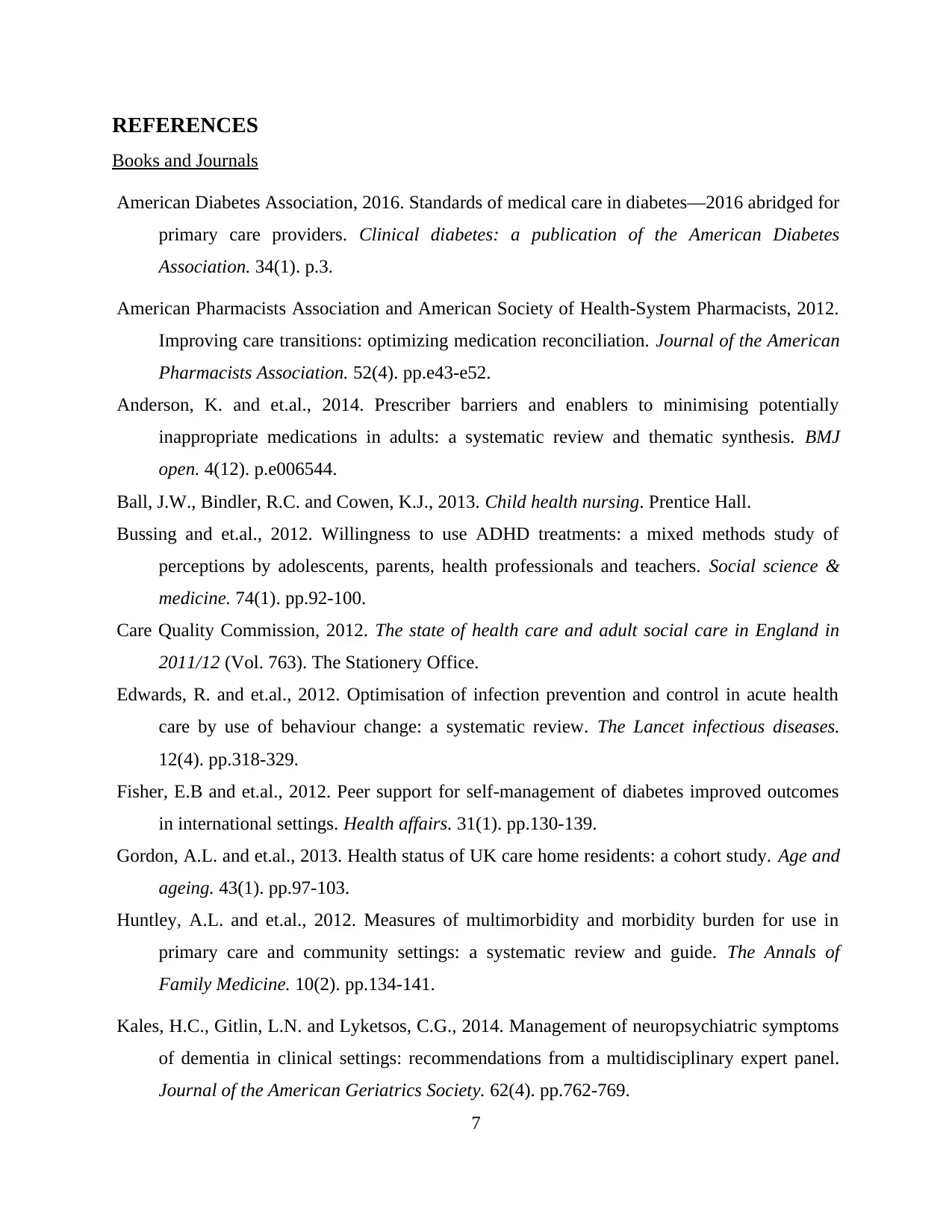
REFERENCES
Books and Journals
American Diabetes Association, 2016. Standards of medical care in diabetes—2016 abridged for
primary care providers. Clinical diabetes: a publication of the American Diabetes
Association. 34(1). p.3.
American Pharmacists Association and American Society of Health-System Pharmacists, 2012.
Improving care transitions: optimizing medication reconciliation. Journal of the American
Pharmacists Association. 52(4). pp.e43-e52.
Anderson, K. and et.al., 2014. Prescriber barriers and enablers to minimising potentially
inappropriate medications in adults: a systematic review and thematic synthesis. BMJ
open. 4(12). p.e006544.
Ball, J.W., Bindler, R.C. and Cowen, K.J., 2013. Child health nursing. Prentice Hall.
Bussing and et.al., 2012. Willingness to use ADHD treatments: a mixed methods study of
perceptions by adolescents, parents, health professionals and teachers. Social science &
medicine. 74(1). pp.92-100.
Care Quality Commission, 2012. The state of health care and adult social care in England in
2011/12 (Vol. 763). The Stationery Office.
Edwards, R. and et.al., 2012. Optimisation of infection prevention and control in acute health
care by use of behaviour change: a systematic review. The Lancet infectious diseases.
12(4). pp.318-329.
Fisher, E.B and et.al., 2012. Peer support for self-management of diabetes improved outcomes
in international settings. Health affairs. 31(1). pp.130-139.
Gordon, A.L. and et.al., 2013. Health status of UK care home residents: a cohort study. Age and
ageing. 43(1). pp.97-103.
Huntley, A.L. and et.al., 2012. Measures of multimorbidity and morbidity burden for use in
primary care and community settings: a systematic review and guide. The Annals of
Family Medicine. 10(2). pp.134-141.
Kales, H.C., Gitlin, L.N. and Lyketsos, C.G., 2014. Management of neuropsychiatric symptoms
of dementia in clinical settings: recommendations from a multidisciplinary expert panel.
Journal of the American Geriatrics Society. 62(4). pp.762-769.
7
Books and Journals
American Diabetes Association, 2016. Standards of medical care in diabetes—2016 abridged for
primary care providers. Clinical diabetes: a publication of the American Diabetes
Association. 34(1). p.3.
American Pharmacists Association and American Society of Health-System Pharmacists, 2012.
Improving care transitions: optimizing medication reconciliation. Journal of the American
Pharmacists Association. 52(4). pp.e43-e52.
Anderson, K. and et.al., 2014. Prescriber barriers and enablers to minimising potentially
inappropriate medications in adults: a systematic review and thematic synthesis. BMJ
open. 4(12). p.e006544.
Ball, J.W., Bindler, R.C. and Cowen, K.J., 2013. Child health nursing. Prentice Hall.
Bussing and et.al., 2012. Willingness to use ADHD treatments: a mixed methods study of
perceptions by adolescents, parents, health professionals and teachers. Social science &
medicine. 74(1). pp.92-100.
Care Quality Commission, 2012. The state of health care and adult social care in England in
2011/12 (Vol. 763). The Stationery Office.
Edwards, R. and et.al., 2012. Optimisation of infection prevention and control in acute health
care by use of behaviour change: a systematic review. The Lancet infectious diseases.
12(4). pp.318-329.
Fisher, E.B and et.al., 2012. Peer support for self-management of diabetes improved outcomes
in international settings. Health affairs. 31(1). pp.130-139.
Gordon, A.L. and et.al., 2013. Health status of UK care home residents: a cohort study. Age and
ageing. 43(1). pp.97-103.
Huntley, A.L. and et.al., 2012. Measures of multimorbidity and morbidity burden for use in
primary care and community settings: a systematic review and guide. The Annals of
Family Medicine. 10(2). pp.134-141.
Kales, H.C., Gitlin, L.N. and Lyketsos, C.G., 2014. Management of neuropsychiatric symptoms
of dementia in clinical settings: recommendations from a multidisciplinary expert panel.
Journal of the American Geriatrics Society. 62(4). pp.762-769.
7
⊘ This is a preview!⊘
Do you want full access?
Subscribe today to unlock all pages.

Trusted by 1+ million students worldwide
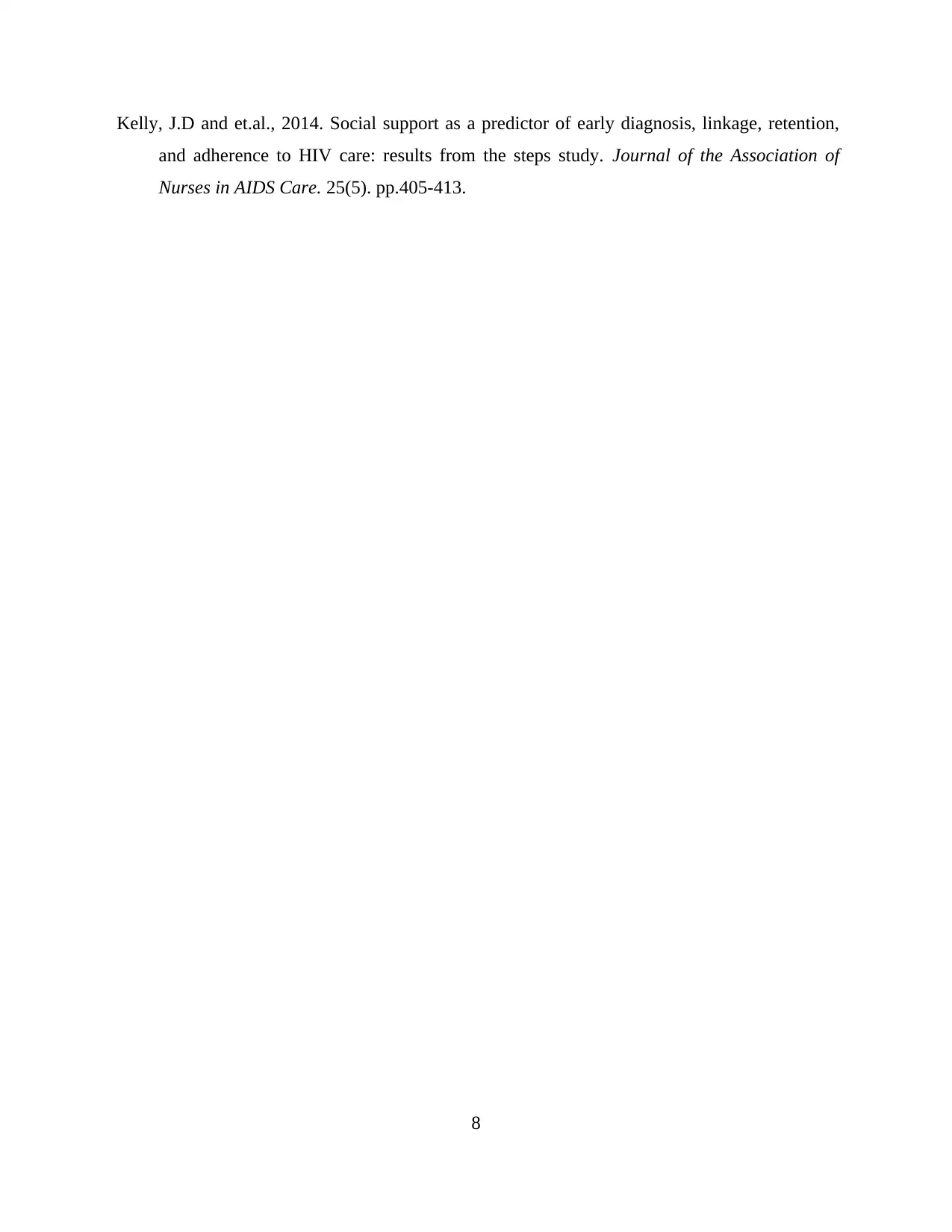
Kelly, J.D and et.al., 2014. Social support as a predictor of early diagnosis, linkage, retention,
and adherence to HIV care: results from the steps study. Journal of the Association of
Nurses in AIDS Care. 25(5). pp.405-413.
8
and adherence to HIV care: results from the steps study. Journal of the Association of
Nurses in AIDS Care. 25(5). pp.405-413.
8
Paraphrase This Document
Need a fresh take? Get an instant paraphrase of this document with our AI Paraphraser

9
1 out of 11
Related Documents
Your All-in-One AI-Powered Toolkit for Academic Success.
+13062052269
info@desklib.com
Available 24*7 on WhatsApp / Email
![[object Object]](/_next/static/media/star-bottom.7253800d.svg)
Unlock your academic potential
Copyright © 2020–2025 A2Z Services. All Rights Reserved. Developed and managed by ZUCOL.





